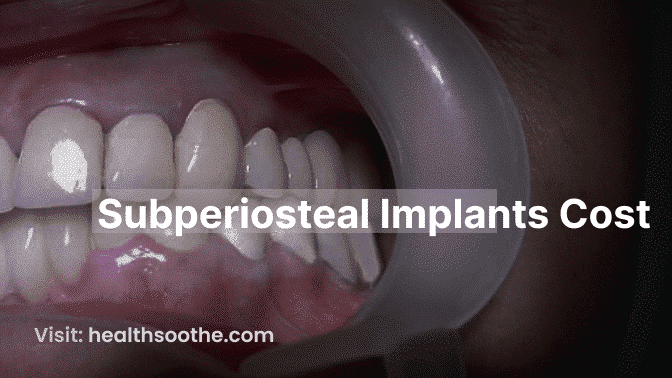When it comes to restoring missing teeth, dental implants are widely recognized as a durable and aesthetically pleasing solution.
Among the various types of dental implants available, subperiosteal implants offer a viable alternative for individuals with insufficient jawbone density or those who are unable to undergo traditional implant procedures.
However, before deciding on subperiosteal implants, it’s essential to delve into the financial aspects associated with this treatment option.
Explanation of Subperiosteal Implants and Their Benefits
Subperiosteal implants are customized dental implants that are placed beneath the gum tissue but above the jawbone.
They are designed to adapt to the unique shape and contours of an individual’s jaw, providing a stable foundation for dental restorations such as crowns, bridges, or dentures.
This innovative implant design allows individuals with jawbone deficiencies or anatomical limitations to enjoy the benefits of dental implants.
Understanding the Need for Subperiosteal Implants
Subperiosteal implants may be recommended in situations where there is inadequate bone volume to support traditional implants.
This could be due to bone loss resulting from periodontal disease, previous tooth extractions, or natural jaw structure variations.
By opting for subperiosteal implants, individuals can bypass the need for bone grafting procedures and still achieve optimal oral function and aesthetics.
Factors Influencing Subperiosteal Implant Costs
- Material Costs: The type and quality of materials used in subperiosteal implants, such as titanium or zirconia, can affect the overall cost.
- Surgical Fees: The complexity of the surgical procedure and the expertise of the dental professional performing it can influence the cost.
- Laboratory Fees: The fabrication of customized subperiosteal implants by dental laboratories incurs additional expenses.
- Pre-operative Examinations: Diagnostic tests, such as X-rays and CT scans, are typically conducted to assess the condition of the jawbone, and these can impact the overall cost.
- Anaesthesia Fees: Depending on the patient’s preferences and the complexity of the procedure, the use of anaesthesia can contribute to the cost.
- Follow-up Care and Maintenance Costs: Post-operative visits, check-ups, and potential adjustments to the implant restoration may be necessary, adding to the total expense.
Read Also: Affordable Implants Dental: What You Need to Know
Average Cost Range of Subperiosteal Implants
The cost of subperiosteal implants can vary widely depending on factors such as geographic location, the dentist’s experience, and the complexity of the case.
On average, the cost can range from $3,000 to $6,000 per implant. It’s important to note that this estimate includes the implant placement procedure, but not the final restoration.
Additional Expenses to Consider
- Bone Grafting Costs: In cases where significant bone loss is present, bone grafting procedures may be required to enhance the jawbone’s strength and volume, leading to additional costs.
- Diagnostic Imaging Costs: Pre-operative imaging, such as panoramic X-rays or CT scans, is essential to evaluate the jawbone’s condition and may involve additional expenses.
- Medication and Post-operative Care Costs: Prescribed medications, pain management, and post-operative care instructions should be considered when budgeting for subperiosteal implant treatment.
Factors That May Affect the Final Cost
- Geographical Location: The cost of dental treatments can vary based on the region, city, or even the specific dental practice.
- Dentist’s Experience and Reputation: Highly experienced and renowned dental professionals may charge higher fees due to their expertise and success rate.
- The complexity of the Case: If additional procedures, such as extractions or bone grafting, are required alongside subperiosteal implant placement, the overall cost may increase accordingly.
Financing Options and Dental Insurance Coverage for Subperiosteal Implants
Many dental practices offer financing options to help patients manage the cost of subperiosteal implants. Additionally, dental insurance plans may provide partial coverage for implant procedures. It is advisable to consult with the dental office and insurance provider to determine the extent of coverage and explore available financing options.
Tips for Finding Affordable Subperiosteal Implant Options
- Research Multiple Dental Practices: Compare the costs and reputation of different dental practices to find an affordable and reliable option.
- Seek Recommendations: Ask friends, family, or your regular dentist for recommendations on trustworthy dental professionals who offer competitive prices.
- Explore Dental Schools or Teaching Institutions: Consider seeking treatment from dental schools or teaching institutions where experienced faculty oversee the procedures performed by students, often at reduced costs.
- Consider Dental Tourism: Dental tourism involves travelling to another country where dental treatments are often more affordable without compromising quality. Research popular dental tourism destinations known for their reputable dental clinics and affordable implant options.
- Inquire About Discounts or Promotions: Don’t hesitate to ask dental practices if they offer any discounts or promotions for subperiosteal implants. Some clinics may have special offers for new patients, seasonal promotions, or discounted rates for multiple implants.
Conclusion
Subperiosteal implants can be a game-changer for individuals with insufficient jawbone density or anatomical limitations. Understanding the factors that contribute to subperiosteal implant costs is crucial for making informed decisions about dental treatment.
By considering the materials, surgical fees, laboratory costs, and other factors, individuals can better plan their finances and explore suitable financing options. Remember to consult with a qualified dental professional to assess your specific needs and discuss the cost implications before embarking on the subperiosteal implant journey.
FAQ 1: Q: What are subperiosteal implants?
A: Subperiosteal implants are a type of dental implant used to replace missing teeth. Unlike traditional dental implants that are inserted into the jawbone, subperiosteal implants are placed on or above the jawbone, beneath the gum tissue.
FAQ 2: Q: How much do subperiosteal implants cost?
A: The cost of subperiosteal implants can vary depending on factors such as the number of implants needed, the complexity of the procedure, the location of the dental practice, and the dentist's experience. On average, the cost of subperiosteal implants can range from $3,000 to $6,000 per implant.
FAQ 3: Q: Does dental insurance cover the cost of subperiosteal implants?
A: Dental insurance coverage for subperiosteal implants can vary depending on the insurance plan. Some dental insurance plans may offer partial coverage for dental implants, while others may not cover them at all. It is best to review your dental insurance policy or contact your insurance provider to understand the specifics of your coverage.
FAQ 4: Q: Are there any financing options available for subperiosteal implants?
A: Many dental practices offer financing options to help patients manage the cost of subperiosteal implants. These may include monthly payment plans, dental financing companies, or third-party credit options. It is recommended to discuss financing options with your dentist
. FAQ 5: Q: Are there alternative options to subperiosteal implants?
A: Subperiosteal implants are one of several options for replacing missing teeth. Alternative options include traditional dental implants that are inserted into the jawbone, removable dentures, or dental bridges. The most suitable option will depend on factors such as the patient's oral health, bone density, and personal preferences. It is best to consult with a dentist to determine the most appropriate treatment option for your specific needs.





